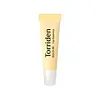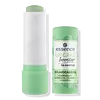What's inside
What's inside
 Key Ingredients
Key Ingredients

 Benefits
Benefits

 Concerns
Concerns

 Ingredients Side-by-side
Ingredients Side-by-side

Polyisobutene
Petrolatum
EmollientDiisostearyl Malate
EmollientSimmondsia Chinensis Seed Oil
EmollientButyrospermum Parkii Butter
Skin ConditioningSorbitan Sesquioleate
EmulsifyingMacadamia Ternifolia Seed Oil
EmollientOlea Europaea Fruit Oil
MaskingAdansonia Digitata Seed Oil
EmollientCeramide NP
Skin ConditioningCeramide Ns
Skin ConditioningCeramide As
Skin ConditioningCeramide EOP
Skin ConditioningCeramide AP
Skin ConditioningStearic Acid
CleansingCholesterol
EmollientVinegar
Sodium Hyaluronate
HumectantPanthenol
Skin ConditioningTrehalose
HumectantHydrogenated Lecithin
EmulsifyingMicrocrystalline Wax
Emulsion StabilisingSargassum Fusiforme Extract
Skin ProtectingGlycerin
HumectantButylene Glycol
HumectantWater
Skin ConditioningCaprylic/Capric Triglyceride
Masking1,2-Hexanediol
Skin ConditioningPolyisobutene, Petrolatum, Diisostearyl Malate, Simmondsia Chinensis Seed Oil, Butyrospermum Parkii Butter, Sorbitan Sesquioleate, Macadamia Ternifolia Seed Oil, Olea Europaea Fruit Oil, Adansonia Digitata Seed Oil, Ceramide NP, Ceramide Ns, Ceramide As, Ceramide EOP, Ceramide AP, Stearic Acid, Cholesterol, Vinegar, Sodium Hyaluronate, Panthenol, Trehalose, Hydrogenated Lecithin, Microcrystalline Wax, Sargassum Fusiforme Extract, Glycerin, Butylene Glycol, Water, Caprylic/Capric Triglyceride, 1,2-Hexanediol
Caprylic/Capric Triglyceride
MaskingPolyisobutene
Cera Microcristallina
Emulsion StabilisingPersea Gratissima Oil
Skin ConditioningTocopheryl Acetate
AntioxidantEuphorbia Cerifera Wax
Silica Dimethyl Silylate
EmollientCanola Oil
EmollientHelianthus Annuus Seed Oil
EmollientBambusa Arundinacea Stem Extract
Skin ConditioningEthylhexyl Palmitate
EmollientCaprylyl Glycol
EmollientGlycerin
HumectantCaprylhydroxamic Acid
Daucus Carota Sativa Seed Oil
EmollientBeta-Carotene
Skin ConditioningDaucus Carota Sativa Root Extract
Skin ConditioningAlumina
AbrasiveParfum
MaskingCI 42090
Cosmetic ColorantCI 77891
Cosmetic ColorantCaprylic/Capric Triglyceride, Polyisobutene, Cera Microcristallina, Persea Gratissima Oil, Tocopheryl Acetate, Euphorbia Cerifera Wax, Silica Dimethyl Silylate, Canola Oil, Helianthus Annuus Seed Oil, Bambusa Arundinacea Stem Extract, Ethylhexyl Palmitate, Caprylyl Glycol, Glycerin, Caprylhydroxamic Acid, Daucus Carota Sativa Seed Oil, Beta-Carotene, Daucus Carota Sativa Root Extract, Alumina, Parfum, CI 42090, CI 77891
 Reviews
Reviews

Ingredients Explained
These ingredients are found in both products.
Ingredients higher up in an ingredient list are typically present in a larger amount.
This ingredient is an emollient, solvent, and texture enhancer. It is considered a skin-softener by helping the skin prevent moisture loss.
It helps thicken a product's formula and makes it easier to spread by dissolving clumping compounds.
Caprylic Triglyceride is made by combining glycerin with coconut oil, forming a clear liquid.
While there is an assumption Caprylic Triglyceride can clog pores due to it being derived from coconut oil, there is no research supporting this.
Learn more about Caprylic/Capric TriglycerideGlycerin is already naturally found in your skin. It helps moisturize and protect your skin.
A study from 2016 found glycerin to be more effective as a humectant than AHAs and hyaluronic acid.
As a humectant, it helps the skin stay hydrated by pulling moisture to your skin. The low molecular weight of glycerin allows it to pull moisture into the deeper layers of your skin.
Hydrated skin improves your skin barrier; Your skin barrier helps protect against irritants and bacteria.
Glycerin has also been found to have antimicrobial and antiviral properties. Due to these properties, glycerin is often used in wound and burn treatments.
In cosmetics, glycerin is usually derived from plants such as soybean or palm. However, it can also be sourced from animals, such as tallow or animal fat.
This ingredient is organic, colorless, odorless, and non-toxic.
Glycerin is the name for this ingredient in American English. British English uses Glycerol/Glycerine.
Learn more about GlycerinPolyisobutene is a synthetic polymer made from isobutene.
It is a film-forming agent and helps bind ingredients together.
Polyisobutene is not absorbed by the skin.
Learn more about Polyisobutene